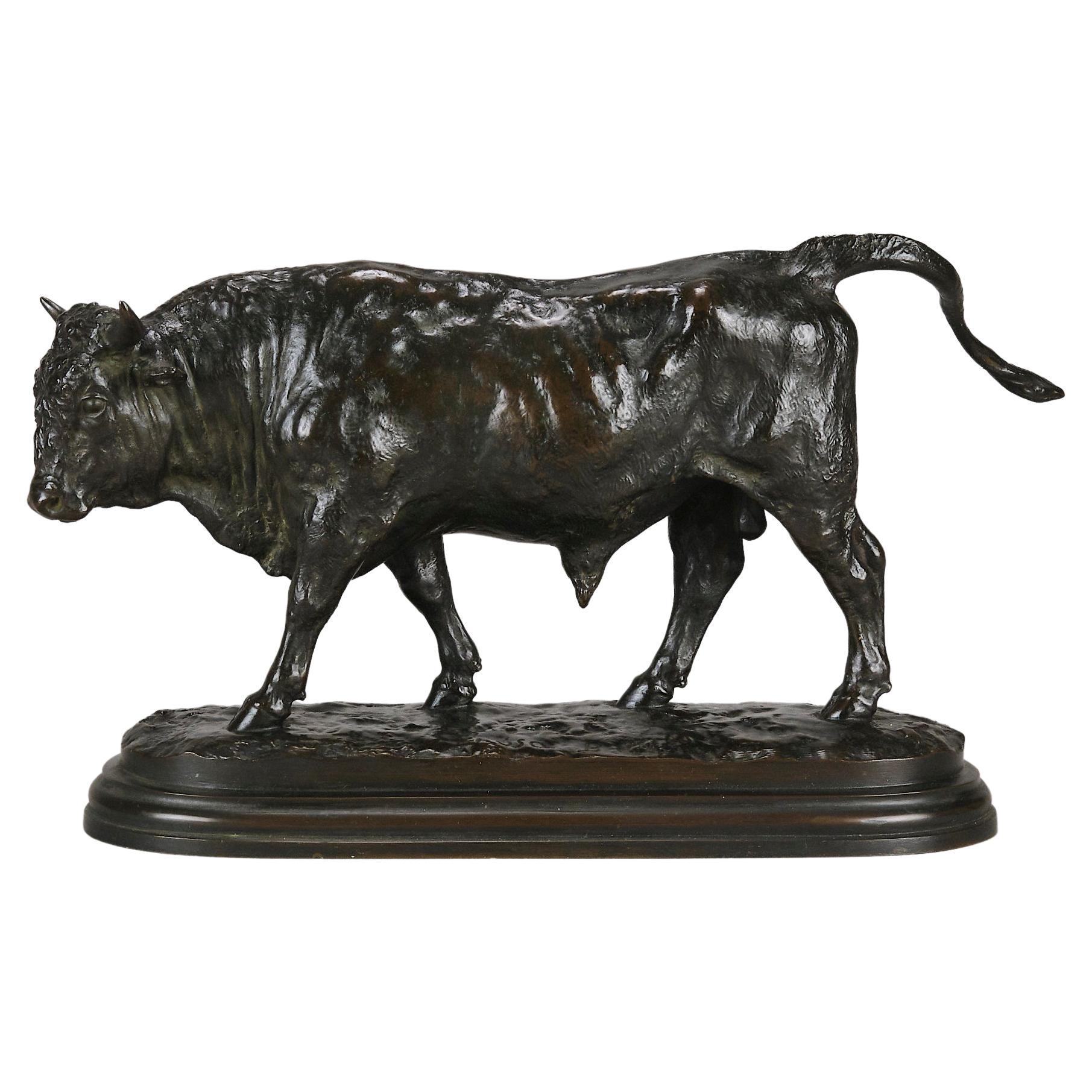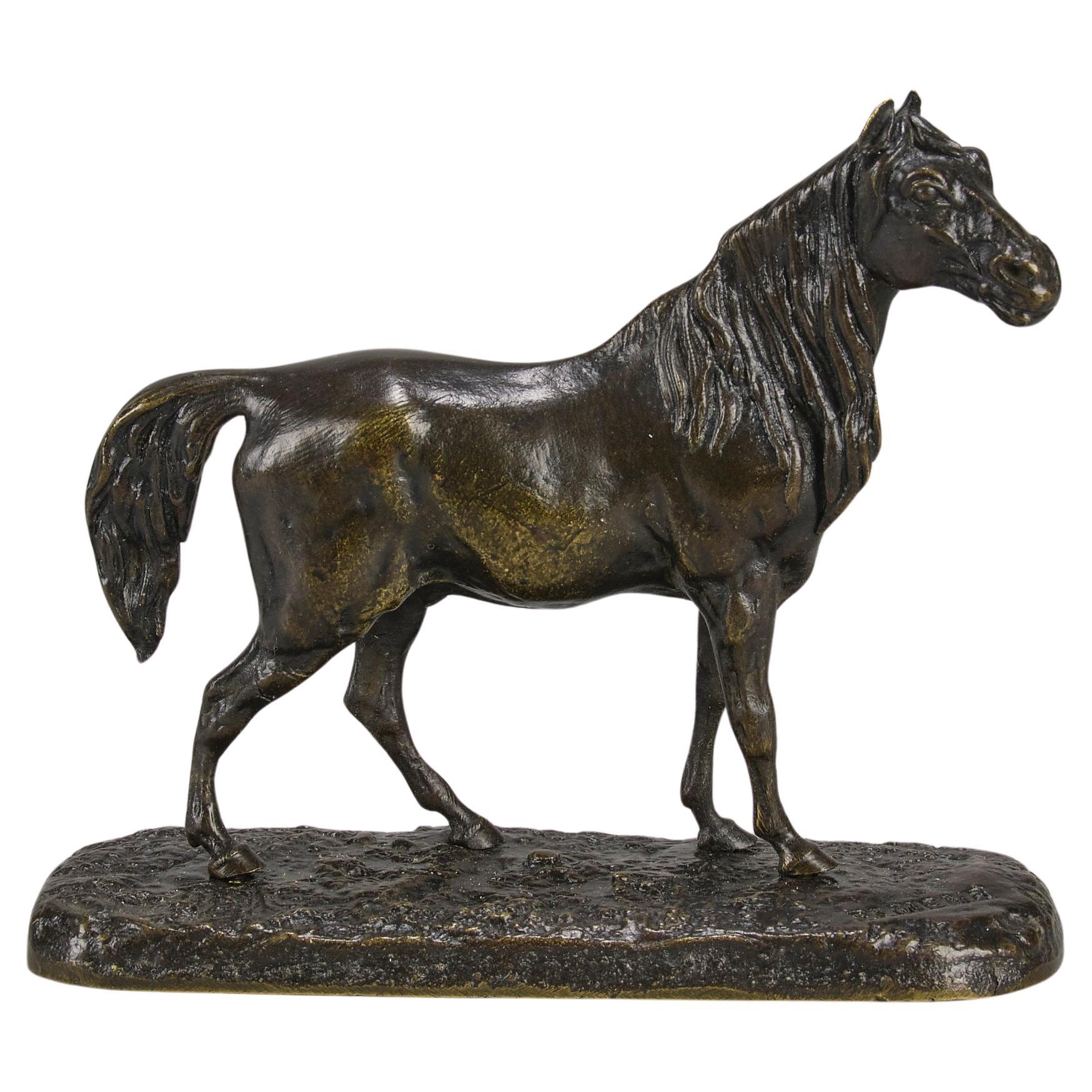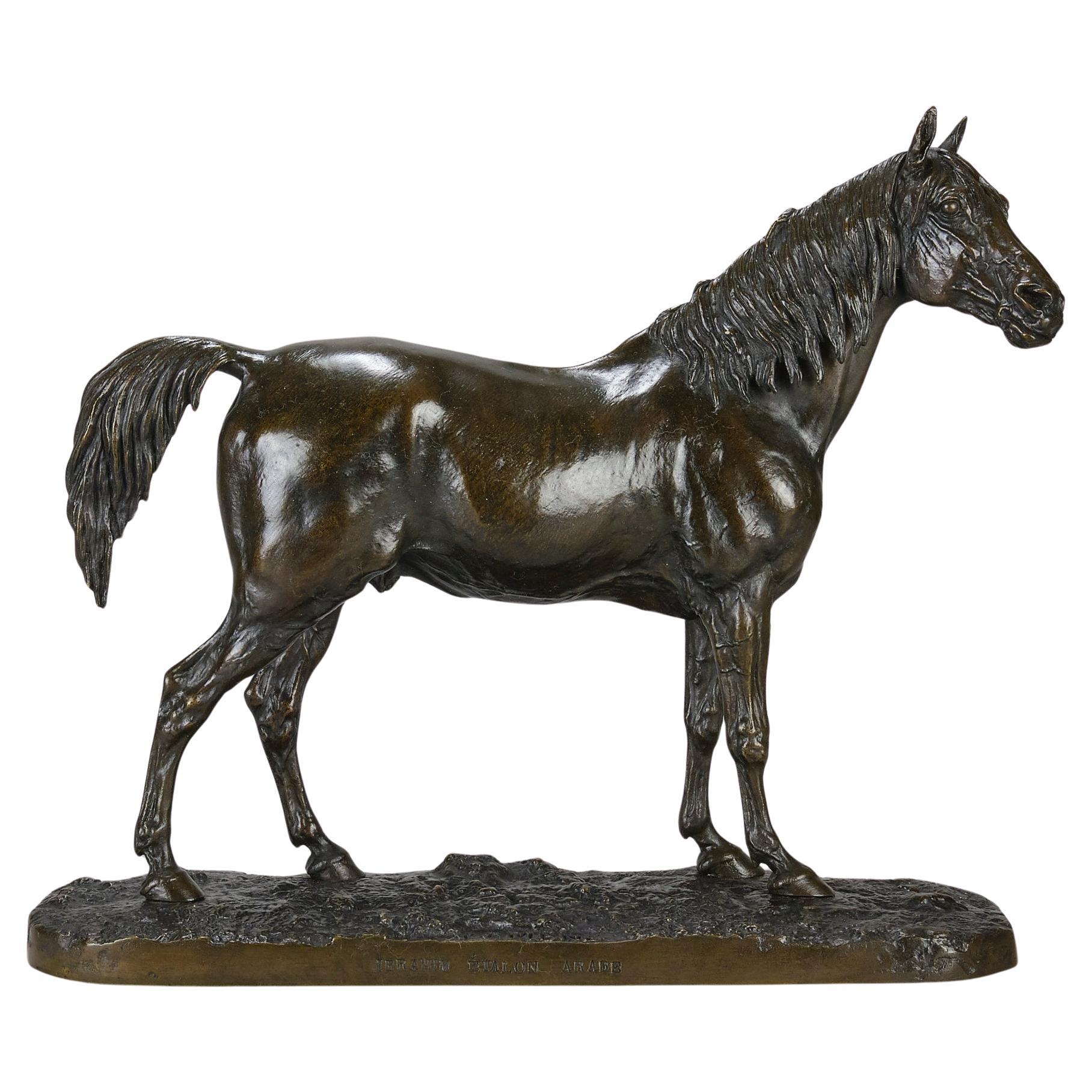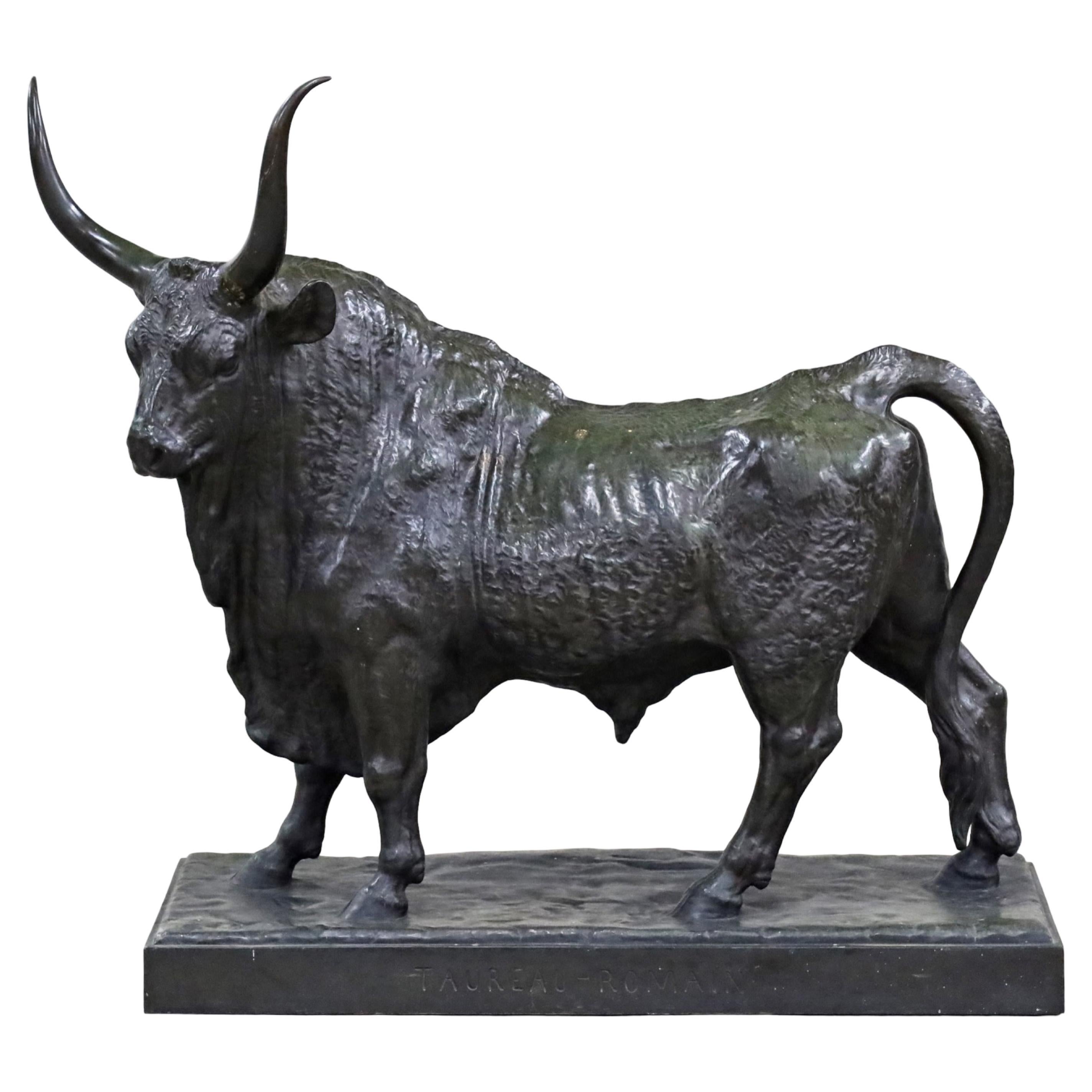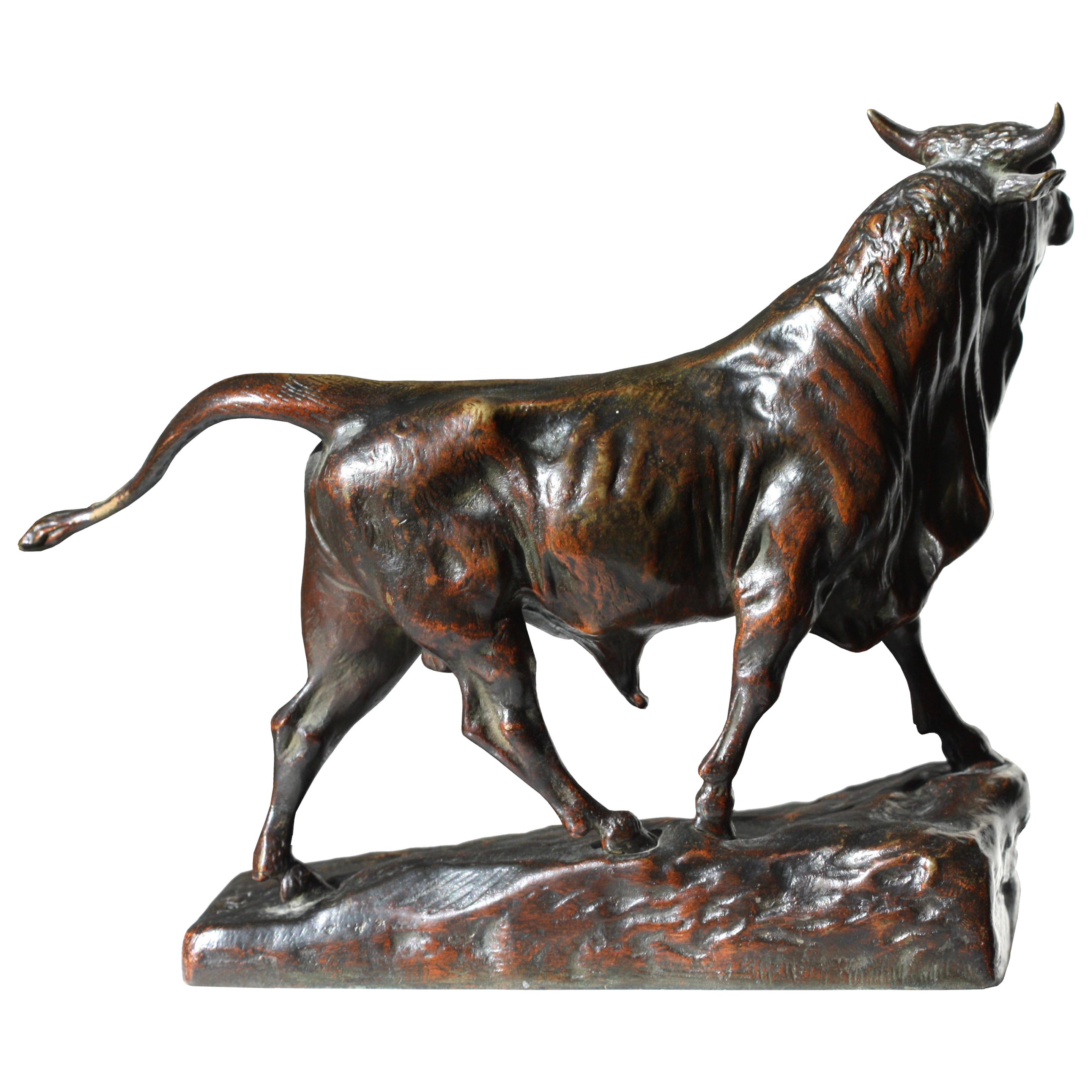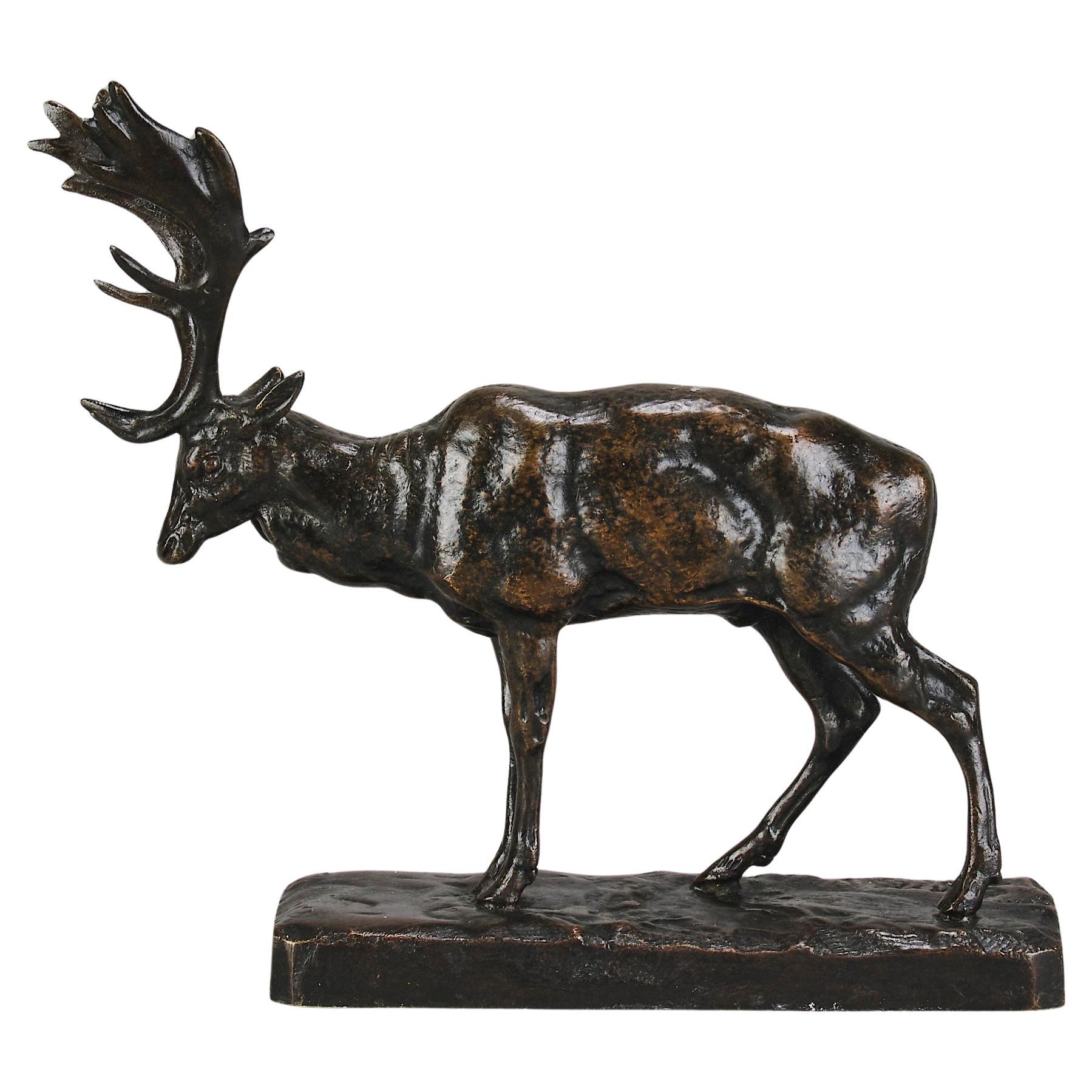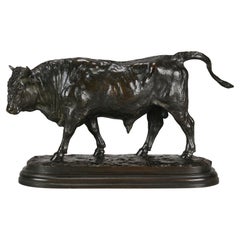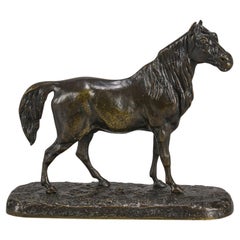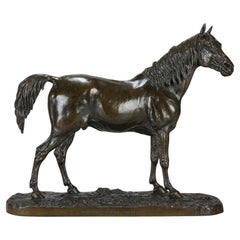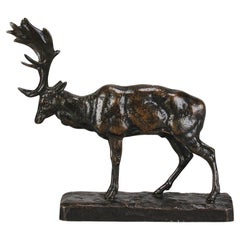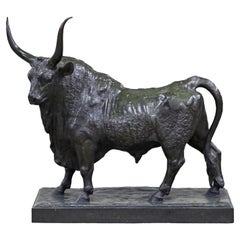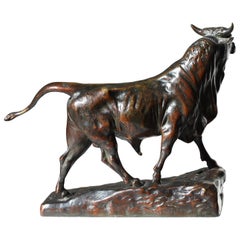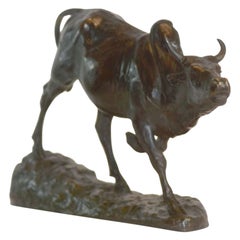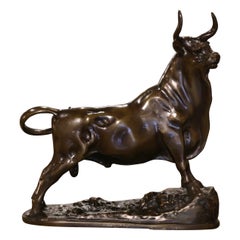Items Similar to 19th Century Animalier Bronze "Taureau Vainqueur" by Jean-Baptiste Clesinger
Want more images or videos?
Request additional images or videos from the seller
1 of 17
19th Century Animalier Bronze "Taureau Vainqueur" by Jean-Baptiste Clesinger
$2,818.42
£2,050
€2,411.58
CA$3,858.56
A$4,322.84
CHF 2,250.03
MX$52,643.88
NOK 28,662.41
SEK 26,991.91
DKK 18,002.13
Shipping
Retrieving quote...The 1stDibs Promise:
Authenticity Guarantee,
Money-Back Guarantee,
24-Hour Cancellation
About the Item
An impressive late 19th century French bronze study of a majestic bull with standing in a proud stance exhibiting excellent hand chased surface detail and fine rich brown patina. Raised on an integral base, signed Clesinger, titled and with foundry seal
Additional Information:
Height: 16 cm
Width: 17 cm
Depth: 6 cm
Condition: Excellent Original Condition
circa: 1870
Materials: Bronze
Book Ref: Bronzes of 19th Century by Pierre Kjellberg
Page No.: 218
ABOUT
Jean Baptiste Clesinger ~ French, 1814 to 1883
Jean Baptiste Clesinger, known as Auguste, was born in Besancon in 1814, son of George Philippe, sculptor, and stone mason. A pupil of his father's, he showed for the first time at the Paris Salon in 1843 (bust of Viscount Jules de Valdahon). His father had taken him to Rome in 1832 and he worked in Bertel Thorvaldsen's studio for a while. Upon his return to Paris he worked with David d'Angers maintaining a studio in Rome at the same time.
He caused a scandal at the Salon of 1847 with his work entitled Woman with a Serpent. Model for this life-size marble study of a nude was a well-known courtesan Apollonie Sabatier, Baudelaire's mistress at the time. It is said that the scandal was orchestrated by Theophile Gautier, who spread the rumor that the cast of the statue was taken from life. Not only was Clesinger's fame ensured from then on, but other sculptors began to show the female body in a more realistic form and true to life.
The same year Clesinger married Solange, daughter of George Sand and they had a daughter in 1849. Also in 1849, he received the Cross of the Legion of Honor; he became an Officer in the Order in 1864.
He continued to sculpt, including marble sculptures of animals like The Roman Battle of the Bulls (1856). His later work was influenced by the Greek revivalist movement.
Clesinger's marriage to Solange ended badly and their daughter died of scarlet fever in 1855. In 1864, Auguste Clesinger exhibited for the last time and died in Paris in 18.
- Creator:Jean-Baptiste Clésinger (Artist)
- Dimensions:Height: 2.37 in (6 cm)Width: 6.7 in (17 cm)Depth: 6.3 in (16 cm)
- Style:Art Nouveau (Of the Period)
- Materials and Techniques:
- Place of Origin:
- Period:
- Date of Manufacture:1870
- Condition:Wear consistent with age and use.
- Seller Location:London, GB
- Reference Number:Seller: 88861stDibs: LU3216333205972
About the Seller
5.0
Gold Seller
Premium sellers maintaining a 4.3+ rating and 24-hour response times
Established in 1936
1stDibs seller since 2017
80 sales on 1stDibs
Typical response time: 1 hour
- ShippingRetrieving quote...Shipping from: London, United Kingdom
- Return Policy
Authenticity Guarantee
In the unlikely event there’s an issue with an item’s authenticity, contact us within 1 year for a full refund. DetailsMoney-Back Guarantee
If your item is not as described, is damaged in transit, or does not arrive, contact us within 7 days for a full refund. Details24-Hour Cancellation
You have a 24-hour grace period in which to reconsider your purchase, with no questions asked.Vetted Professional Sellers
Our world-class sellers must adhere to strict standards for service and quality, maintaining the integrity of our listings.Price-Match Guarantee
If you find that a seller listed the same item for a lower price elsewhere, we’ll match it.Trusted Global Delivery
Our best-in-class carrier network provides specialized shipping options worldwide, including custom delivery.More From This Seller
View All19th Century Animalier French Bronze Entitled "Taureau Debout" by Rosa Bonheur
By Rosa Bonheur
Located in London, GB
"Taureau Debout" by Rosa Bonheur.
An excellent late 19th Century French animalier bronze study of a standing bull with fine hand chased surface that accentuates the muscle definition of the subject, signed Rosa B.
ADDITIONAL INFORMATION
Measures: Width: 32 cm
Height: 18 cm
Depth: 11cm
Condition: Excellent Original Condition
Circa: 1870
Materials: Bronze
Book reference: Animals in Bronze by Christopher Payne
Page no. 174
DESCRIPTION
Bonheur, Rosa (1822-1899)
The most popular artist of nineteenth-century France, Rosa Bonheur was also one of the first renowned painters of animals and the first woman awarded the Grand Cross by the French Legion of Honor. A professional artist with a successful career, Bonheur lived in two consecutive committed relationships with women.
Born on March 16, 1822 in Bordeaux, Marie Rosalie Bonheur was the oldest of the four children of Raimond Oscar Bonheur (1796-1849) and Sophie Marquis. Bonheur's father was an art teacher who came from a poor family, while her mother, a musician, had descended from a middle-class family and had been her husband's art student.
Bonheur's father, who taught drawing and landscape painting, was an ardent member of the utopian Saint Simeon society.
The group held idealistic beliefs about the reform of work, property, marriage, and the role of women in society. Most importantly, for the artist's future, the Saint Simeons questioned traditional gender norms and firmly believed in the equality of women. While teaching artistic techniques to his oldest daughter, Raimond Bonheur also encouraged her independence and taught her to consider art as a career.
In 1828 Raimond Bonheur joined the Saint Simeons at their retreat outside Paris. Sophie and the children joined him in Paris the following year. Four years later, however, Raimond abandoned his family to live in isolation with his fellow Saint Simeons.
Sophie Bonheur died in 1833 at the age of thirty-six. Rosa was only eleven years old when her mother died, but she was aware of the heavy price her mother paid for married life with a man who was more dedicated to his own ideals than to meeting his family's needs. Rosa also saw that her mother's marriage led to poverty and her death from exhaustion.
After her mother's death, Bonheur was taken in by the Micas family who resided nearby. Mme Micas and Bonheur's mother had been friends. When Mme Bonheur died, the Micas family paid Raimond Bonheur's debts and cared for Rosa. Their daughther, Nathalie, who would later become an amateur inventor and unschooled veterinarian, and Rosa became enamored with each other.
When Rosa Bonheur began her career as a professional artist, she had already been trained by her father who had allowed her to study in all male classes. Rosa also learned by sketching masterworks at the Louvre from the age of fourteen, and later, by studying with Léon Cogniet.
From the very beginning, Bonheur's favorite subject was animals. She learned their anatomy completely by dissecting them in local slaughterhouses. She also visited the horse market two times a week. Study of animals by direct observation led to the formation of the realist style in which Bonheur worked.
It was for such work that Bonheur obtained written permission from the French government to wear men's slacks. Her working attire also consisted of a loose smock and heavy boots that protected her feet from the dangerous environment in which she painted. The style of dress that the artist adopted for work and home may well have been influenced by her father's attire, which was based on St. Simeonian clothing experiments. Bonheur also cropped her hair, perhaps to facilitate her work. She did, however, always wear dresses for social occasions because she knew that appropriate dress would further her career.
Bonheur earned a successful living as a painter of animals. She exhibited at the annual Paris Salon regularly from the age of nineteen in 1841 through 1853, when she was thirty-one. She won the salon's gold medal at the age of twenty-six in 1848 and was commissioned by the French government to paint Plowing on the Nivernais in 1849. In the same year Bonheur and her sister Juliette became directors of l'École gratuite de dessin pour les jeunes filles, a post their father had once held.
Bonheur completed her most renowned work, The Horse Fair, in 1855. The successful representation of percherons (a breed native to Normandy) was purchased by Ernest Gambart, a London art dealer whose gallery specialized in work by French artists. He exhibited The Horse Fair in London where Bonheur visited with Nathalie. Queen Victoria requested a private viewing of the painting at Windsor Castle. It would later be purchased in 1887 by Cornelius Vanderbilt and donated to the new Metropolitan Museum of Art in New York City.
Bonheur's trip to England allowed her to meet Charles Eastlake, then President of the Royal Academy, John Ruskin, the English writer and critic, and Edwin Landseer, the British animalier. She also toured the English and Scottish countrysides and executed some paintings based on her observations of new breeds of animals found there.
Gambart made engravings of Bonheur's work, including The Horse Fair, and sold them in England, Europe, and the United States. Bonheur became one of the most renowned painters of the time. Little girls, such as Anna Klumpke in the United States, even had dolls in her likeness, much as American girls played with Shirley Temple dolls...
Category
Antique 19th Century French Art Nouveau Animal Sculptures
Materials
Bronze
Late 19th Century Animalier Bronze Sculpture "Cheval Arabe No.3" by Pierre Jules
By Pierre Jules Mêne
Located in London, GB
"Cheval Arabe No.3" by Pierre Jules Mene
An attractive late 19th Century Animalier bronze study of an arab stallion. The bronze exhibiting excellent hand chased surface detail and g...
Category
Antique 19th Century French Art Nouveau Animal Sculptures
Materials
Bronze
Mid 19th Century Animalier Bronze entitled "Ibrahim" by P J Mêne
By Pierre Jules Mêne
Located in London, GB
Excellent French mid 19th Century Animalier bronze portaiture study of the French Derby winner "Ibrahim", with rich brown lightly rubbed patination and fine hand finished surface det...
Category
Antique Mid-19th Century French Art Nouveau Animal Sculptures
Materials
Bronze
Mid 19th Century Animalier Bronze entitled "Daim" by Antoine Louis Barye
By Antoine-Louis Barye
Located in London, GB
An excellent mid 19th Century French bronze animalier figure of a resting stag with its head lowered showing off its impressive antlers. The bronze with attractive rich brown patina ...
Category
Antique Mid-19th Century French Art Nouveau Animal Sculptures
Materials
Bronze
19th Century Animalier Bronze Sculpture entitled "Medor" by Pierre Jules Mene
By Pierre Jules Mêne
Located in London, GB
An excellent mid 19th Century Animalier bronze study of a setter in an alert turning pose with very fine rich brown patina and intricate hand chased surface detail, raised on natural...
Category
Antique Late 19th Century French Art Nouveau Animal Sculptures
Materials
Bronze
Mid 19th Century French Animalier Bronze entitled "Kevel" by Antoine L Barye
By Antoine-Louis Barye
Located in London, GB
An endearing mid 19th Century French bronze animalier study of a standing Kevel with very fine brown patina gently rubbed to a golden hue and intricate hand chased surface detail. R...
Category
Antique Mid-19th Century French Victorian Animal Sculptures
Materials
Marble, Bronze
You May Also Like
Jean-Baptiste Clesinger (French, 1814-1883) Taureau Romain
Located in Dallas, TX
Large bronze model of Taureau Romain, the Roman bull, by Jean-Baptiste Clesinger (French, 1814-1883), rich verde bronze patina, cast by F. Barbedienne Foundeur, marked on base, stamp...
Category
Antique Mid-19th Century French Animal Sculptures
Materials
Bronze
Maurice Favre a French Bronze Bull
Located in West Palm Beach, FL
Maurice Favre (1875-1915)
A French bronze bull
The lean body revealing the rib cage, with multiple folds of skin at the neck, chocolate-brown patina.
Measures: Height 8 in. (20.32...
Category
20th Century Animal Sculptures
Materials
Bronze
Egyptian Cow Animal Bronze Dated 1911 Signed Robert Bousquet (1894-1917)
By Robert Bousquet
Located in Marseille, FR
19th century animal bronze signed Robert Bousquet (1894-1917) dated 1911 representing a humped Egyptian cow called gamus Dimension length 53 cm for 31 cm high and 13.5 cm deep.
Addi...
Category
Antique 19th Century Animal Sculptures
Materials
Bronze
19th Century French Patinated Bronze Bull Sculpture Signed G. Gardet
By George Gardet
Located in Dallas, TX
Place this large bronze bull sculpture in an office or a desk. Crafted in France, circa 1860 and beautifully executed, the patinated bovine...
Category
Antique Late 19th Century French Animal Sculptures
Materials
Bronze
A Fine Animalier School Bronze Figure of a Bull, After Rosa Bonheur (1822-1899)
By Rosa Bonheur
Located in Ottawa, Ontario
Although there is seemingly no apparent foundry mark, this finely cast & patinated animalier bronze known as ‘Bull’ or ‘Taureau Beuglant’ is exemplary in demonstrating exceptional at...
Category
Early 20th Century French Beaux Arts Animal Sculptures
Materials
Bronze
French, Antique Bronze Sculpture of Aberdeen Angus Bull by Isidore Bonheur
By Isidore Jules Bonheur
Located in Shippensburg, PA
ISIDORE JULES BONHEUR
French, 1827-1901
Taureau Aberdeen-Angus" (Standing Aberdeen-Angus Bull)
Patinated sand-cast bronze Signed to base "I. BONHEUR"
Item # 211HDB17Z
An exquisite and very rare casting of an Aberdeen-Angus bull, an unusual and distinctive breed of cattle from Scotland, this sculpture by Isidore Jules Bonheur is almost without a doubt cast by the foundry of his brother-in-law Hippolyte Peyrol and a rather early model as well in light of the distinctive construction method. In her text on the selection of 46 animal bronzes in the collection of the Georgia Museum of Art, Eleanor Luciano notes regarding this model that "Bonheur is never recorded to have been to Scotland, where he would have seen this unusual breed. Rosa Bonheur painted in Scotland, and its seems likely that Isidore would have drawn the idea for this bull either from one of her sketches or from an agricultural show in France. The animal's rich mane and strong modeling make this one of the most successful." Notable is the very fine surface patination which exhibits a glassy finish with a complex range of colors presenting in the body of the bull, overall being medium brown but augmented with an underlying reddish hue against auburn highlights. The base is signed "I. BONHEUR" in the typical manner.
Museum Collections:
* National Gallery of Art, Washington DC, acc. no. 2006.128.3
* Georgia Museum of Art, University of Georgia...
Category
Antique 19th Century French Romantic Animal Sculptures
Materials
Bronze
More Ways To Browse
Serpent Object
19th Century Female Bronze Sculpture
Bronze Serpent
Roman Bronze Statue
Antique Roman Bronze Statues
Art Nouveau Bronze Female
Late 19th Century Bronze Sculpture Of A Woman
Art Nouveau Seal
Art Nouveau Bronze Nude
Statue Woman France
Marble Bull
Female Nude Art Nouveau
French Female Statues
Marble Statue Woman
Art Nouveau Bronze Statue
Marble Statue Of A Woman
19th Century Life Size Bronze Sculpture
Marble Nude Sculpture Woman
